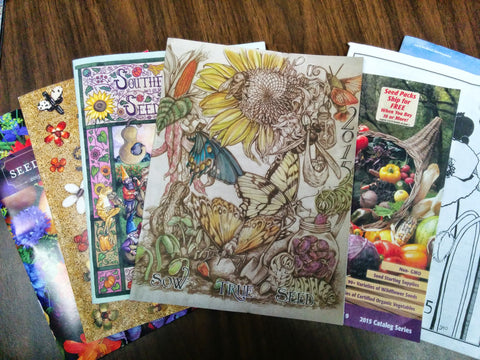
Thousands of catalogs heading out across America in time for Christmas!
It’s that time of year again. Sure, I’m talking about twinkle lights, eggnog, and spending time with family. But I’m equally excited this time every year because all the new seed catalogs start showing up. Every gardener knows the limitless potential and grand fantasies these catalogs represent to us. Page after page of varieties we want to try, more than we realistically know we have room for, so we start mentally planning grand square foot expansions, and rationalizing that our neighbors won’t mind too much as you start creeping over into their yards.
Seed Catalogs and Your Seed Inventory
Only the most disciplined of us open the catalogs for the first time with a practical eye. If you’re anything like me, you’ve looked through them front to back, and then started again with a highlighter to mark all the seeds you want to try before finally sinking a little closer to earth and paring down the list to something that will remotely fit in the garden beds you have. I’ve been going through this yearly cycle of dirt-oriented-optimism for almost two decades now, so I thought I’d share with you my strategy for not under or over buying, and not ending up with twenty different tomatoes, but no lettuce.
I now see the arrival of seed catalogs as not just an exciting representation of all that I will be eating the following year, but also as a reminder to do my yearly seed inventory. As we become more experienced as gardeners, we learn that many seeds often will last longer than just the year that is printed on the packets. We also learn how easy it is to save some types of seed, and we start incorporating saved seed into our stash as well. Different sources, age, and any pertinent notes are all things that I like to keep track of, they help me know from one year to the next what I need to be ordering in order to grow everything I want to the following year to support my family.

Depending on the extent of your seed supply, you may find it easiest to write your inventory in a notebook, (maybe your garden journal?). Or you can geek out like me, and type it into an excel spreadsheet. I love excel, because it allows me to type in all of the info that I may or may not find useful in the future, and I can save a copy from one year to the next so I can look back at past notes if I need to. When you’re looking through your new seed catalogs, it will be enormously helpful to have a page, whether on paper or computer, to reference to see what you have on hand already.
Writing It All Down
It can be as simple as: Lettuce, 4 packets, or something more elaborate like what I do, but either way it’ll be worth it, I promise. Here is how I organize my seeds. Each seed type gets its own line, and on each line I put: type and variety, latin name, source, year packed or collected, approximate amount on hand, and notes. For example:
Bean, bush / Dragon Tongue / Phaseolus vulgaris / Sow True Seed / 2014 / full packet / allow to dry an extra week on the vine for seed saving…
Bean, pole / Kentucky Wonder / Phaseolus vulgaris / Self-collected / 2012 / ½ jelly jar full / vigorous grower, one plant will provide enough seed to last 3 years.
By keeping a detailed list of what I have on hand, I can see patterns such as: I have four types of cauliflower and at least three of those should still be viable, I don’t need any more cauliflower this year. I only have one type of radish left though, since last year I went on a radish bender, so I should get a few more radish packets.
Notes To Self
I can also see things like: I have two types of okra, which are also clearly marked with a note to myself saying:
“Hey Angie, remember you don’t like okra so stop buying it!”
Quite helpful for curbing over-enthusiasm. I hope this helps you all get organized and buy appropriately this year. It’s much more satisfying to get all those new tomato seeds in the mail when you don’t open them and realize you have the exact same varieties already.
Do any of you organize your seeds this way? Differently? Please share in the comments so we can all learn from you!
Happy Holidays!
ORDER YOUR FREE SEED CATALOG HERE
| |
Article Written by: Angie Lavezzo |
|
About the Author: Angie Lavezzo is the former general manager of Sow True Seed. Beyond her professional role at Sow True, Angie's passion for gardening extends into personal hands-on experience, fostering plants and reaping bountiful harvests. |


